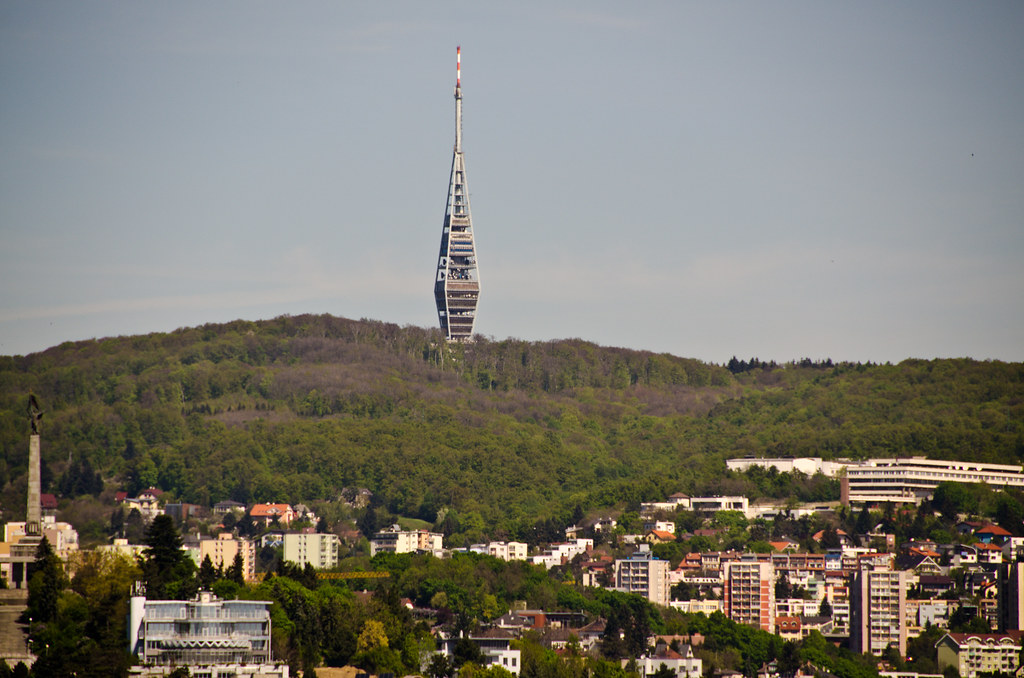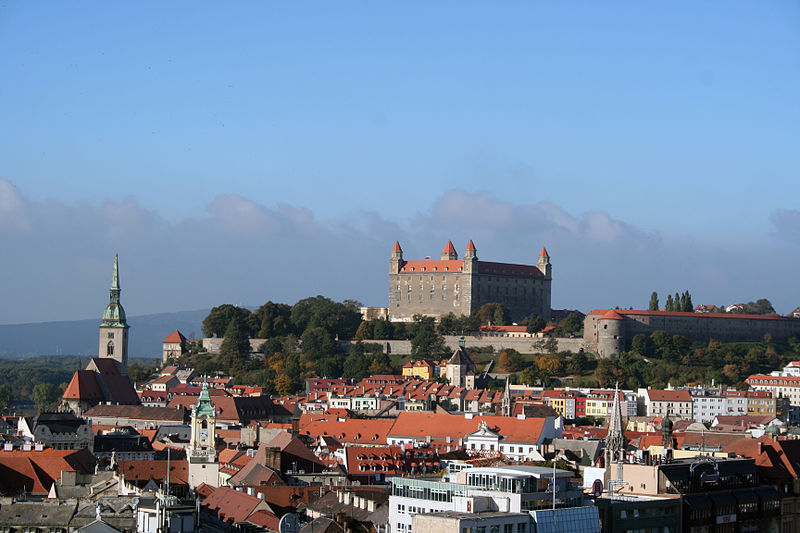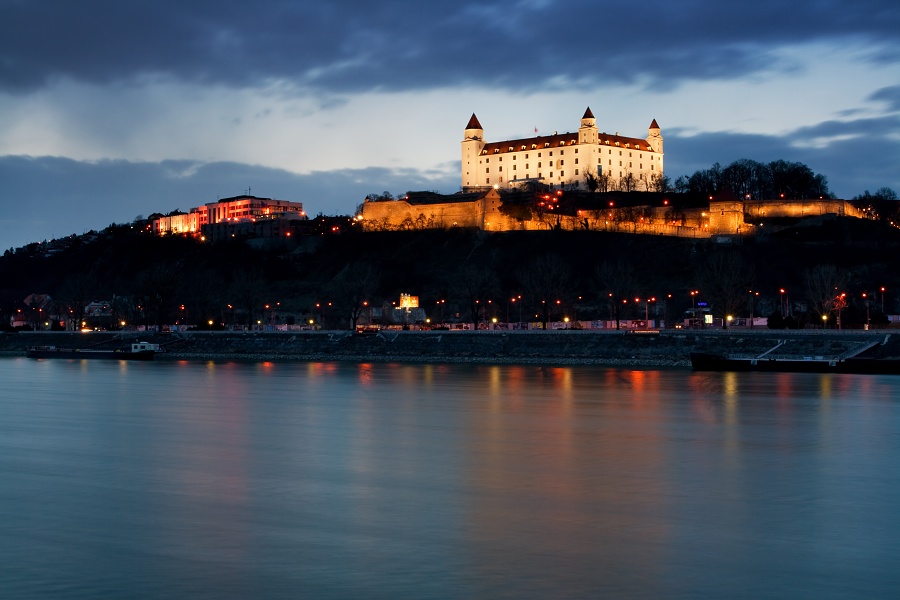Three weeks into this back blow-out, and I felt like I wasn't making adequate progress. In the past it would take two weeks tops to recover from throwing out my back, so I was feeling a bit freaked out and helpless about the whole thing.
Naturally, it made sense to go back to the doctor at the catholic/state-run facility to see if there was any more he could do. As soon as we walked in the room, he acted strangely irritated, as if it were somehow disrespectful of us to come back and suggest that what he'd initially prescribed had been inadequate. He then told us to go to a real hospital and get an MRI. Terezia asked if there was anything he could do then and there to help ease the pain. At that point he snapped and went into this lengthy tirade about how he just treats people with minor aches and pains and what the hell do we expect him to do anyway! Then he accused us of coming to Slovakia specifically to take advantage of its health care system so as to deal with what must be a chronic, pre-existing condition.
Right! As if we'd come to some mecca of socialized medicine like Sweden or Canada! Please. With doctors like this, people must be clamoring to get into this country!
He then accused us of lying, and insisted that we weren't divulging the whole story with my back, which was strange given that we most definitely had told him at our first visit that I'd had lower back issues in the past. Terezia, in complete disbelief at how our presence had stirred this lazy doctor's rage, asked, "So you're not going to do anything?! You're just going to let him suffer?!" He threw his hands in the air and begrudgingly agreed to go ahead and give me an injection (if that would get us the hell out of his office!), but then his nurse blocked him, asking when I'd last taken the Aflamil he prescribed. I stupidly said I'd taken some that morning, and she said no way, no injection, since I'd already taken the pill. Never mind that taking these pills twice (or more) a day has nowhere near the effect of a good injection!
We were shocked at how this sad excuse for a doctor acted completely unprofessionally and got very defensive when Terezia called him on his refusal to actually get out of his chair and do something. I've dealt with an asshole doctor or two in the past, but I've never encountered anything like this useless creep. If anything, this guy's unsympathetic behavior smacked of the kind of old-school, communist-era style of customer service, meaning, a complete and utter lack of it.
We went to the hospital in Ruzinov, but of course we couldn't schedule an MRI until late July (it was mid-May at this point). However, we decided to see the orthopedic doctor there, and she turned out to be much more professional, helpful, and hands-on. Perhaps a little too hands on, as Terezia was convinced that this 40-something woman had a "thing" for me. She had me strip to my underwear (with echoes of Tomas' "Take off your clothes," from Milan Kundera's The Unbearable Lightness of Being) and spent 45 minutes crawling all over me on the massage table with what Terezia described as this gleeful little grin on her face. All I can say is that unlike Dr. Jerkface at the catholic state-run place, this doctor asked me a slew of questions, had me bending around in a million different positions so as to pinpoint and better understand the problem, and prescribed me a more thorough and extensive round of physical therapy and treatments. I had complete confidence in this doctor since she was actually doing her job and taking my problem seriously.
The treatments/therapy involved 20 minutes of lying on my stomach with a sheet of piping hot paraffin wax on my back, followed by 15 minutes of electrodes, and a five minute light massage done with this gun-shaped thing with a smooth, warm steel ball at the tip. They also put me in traction, whereby they strapped me to a mechanical table with a massive leather belt wrapped around my pelvis, then using the large, round communist-era dials on the front panel, they tilted the table so that I was basically hanging with my head pointing downward at what felt like a 25-degree angle, and left me there for five to eight minutes. Everything but the electrodes was new to me! These treatments were followed by pilates/core exercises (some of which I was already well acquainted with) with a really nice girl named Lucia who, luckily, spoke just enough English to be able to explain what to do.
One morning when I was sitting outside Lucia's office before my physical therapy session, the "Take off your clothes" doctor saw me when walking down the hall. She came right up to me, leaned in very close, and put her hands on my knees, with her face literally inches away from mine, totally invading my space bubble. Staring straight and unblinkingly into my eyes, she asked me how I was doing. I replied matter of factly that things were going well, that I was doing the exercises, but that I was not yet back to normal. With her face still inches away from mine, she spent a few minutes extolling the virtues of proper breathing and a daily regimen of core exercises.
I also went in for a daily infusion of painkillers via an IV for an hour per day for five days. I'd basically lie there in a dental chair hooked up to an IV and read, after which I'd feel really drowsy during the tram ride home. I'm not sure what they were giving me or how much it really helped, but it certainly didn't hurt. The young nurse there spoke very limited English, and when prepping the needle she would always say "Now I inject you" with her thick Soviet spy accent. (By the way, I've noticed that absolutely none of the nurses in Slovakia who have given me shots or IVs have ever worn gloves. In the US, nurses and doctors always wear nitrile or latex gloves when working with needles and administering shots.)
After a week and a half of physical therapy, I went back to Doctor Take-off-your-clothes for a follow-up. She had me strip down again, climbed all over me while I was on her table, and then prescribed another round of treatments, this time including a heat lamp and a more strenuous set of exercises with Lucia.
Now, in late June, I've completed the treatments and I'm feeling significantly better, although perhaps not quite 100 percent back to normal. My spine has been straight for a while now, and sitting (and getting up afterwards) is much better, but some types of chairs (usually of the scooped or bucketed variety, especially car seats or low and deep couches) are still a bit problematic. Sometimes I wake up in the morning with stiffness in my lower back. The doctor suggested I go out to Raca, a Bratislava suburb to the northeast of the city, to apparently the only store in the greater metropolitan area (!) that sells lumbar support cushions (which I especially needed for those frequent car trips to the in-laws' house, 2.5 hours away) to buy one. Unfortunately, after an hour in the car it flattens like a pancake, so I've had to have someone find and mail me my really good lumbar support cushion from back home. Meanwhile, I'm doing my best to do the pilates exercises at least five times a week. Of all the back blow-outs I've had, this was absolutely one of the worst, and I obviously don't want a repeat of it.
After a week and a half of physical therapy, I went back to Doctor Take-off-your-clothes for a follow-up. She had me strip down again, climbed all over me while I was on her table, and then prescribed another round of treatments, this time including a heat lamp and a more strenuous set of exercises with Lucia.
Now, in late June, I've completed the treatments and I'm feeling significantly better, although perhaps not quite 100 percent back to normal. My spine has been straight for a while now, and sitting (and getting up afterwards) is much better, but some types of chairs (usually of the scooped or bucketed variety, especially car seats or low and deep couches) are still a bit problematic. Sometimes I wake up in the morning with stiffness in my lower back. The doctor suggested I go out to Raca, a Bratislava suburb to the northeast of the city, to apparently the only store in the greater metropolitan area (!) that sells lumbar support cushions (which I especially needed for those frequent car trips to the in-laws' house, 2.5 hours away) to buy one. Unfortunately, after an hour in the car it flattens like a pancake, so I've had to have someone find and mail me my really good lumbar support cushion from back home. Meanwhile, I'm doing my best to do the pilates exercises at least five times a week. Of all the back blow-outs I've had, this was absolutely one of the worst, and I obviously don't want a repeat of it.
































